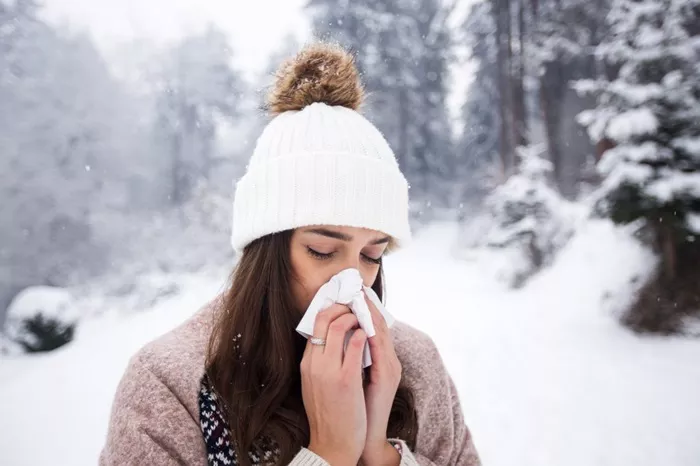As winter settles in, bringing with it the crisp air and frosty mornings, many individuals find relief from the pollen-induced allergies of spring and summer. However, for some, the winter months bring a different set of challenges in the form of allergic rhinitis. Commonly known as hay fever, allergic rhinitis can strike even in the coldest months, causing discomfort and disrupting daily life. In this comprehensive guide, we delve into the various factors that can trigger allergic rhinitis during the winter season, shedding light on its causes and offering strategies for effective management.
Unraveling the Mystery of Winter Allergies
While spring and summer allergies are often associated with pollen from trees, grasses, and weeds, winter allergies can stem from different sources. Understanding the triggers of allergic rhinitis in winter is essential for effective management and symptom relief.
Indoor Allergens: The Culprits Within
One of the primary causes of allergic rhinitis in winter is exposure to indoor allergens. As the weather cools, people spend more time indoors, where various allergens can lurk, triggering allergic reactions. Common indoor allergens include:
Dust Mites: Dust mites thrive in warm, humid environments, making indoor spaces such as bedrooms, living rooms, and carpets ideal breeding grounds. Dust mite allergens, found in their droppings and dead bodies, can become airborne when disturbed, leading to allergic symptoms.
Pet Dander: Pets, such as cats and dogs, can trigger allergic rhinitis in susceptible individuals. Proteins found in pet dander, saliva, and urine can cause allergic reactions when inhaled or come into contact with the skin.
Mold Spores: Mold growth is prevalent in damp and poorly ventilated areas, such as basements, bathrooms, and kitchens. Mold spores released into the air can trigger allergic rhinitis symptoms, particularly in individuals with mold allergies.
Cockroach Allergens: Cockroach infestations are more common in winter months when these pests seek shelter indoors. Cockroach allergens present in their saliva, droppings, and shed skin can exacerbate allergic rhinitis symptoms in sensitized individuals.
Indoor Air Pollution: Indoor air pollutants, such as cigarette smoke, wood-burning stoves, and volatile organic compounds (VOCs) from household products, can irritate the respiratory tract and worsen allergic rhinitis symptoms.
Cold Air Sensitivity: A Seasonal Sensitivity
For some individuals, exposure to cold air can trigger allergic rhinitis symptoms, a condition known as cold-induced rhinitis or cold air hypersensitivity. Cold air can cause the blood vessels in the nasal passages to constrict, leading to nasal congestion, runny nose, and sneezing. Additionally, inhaling cold, dry air can irritate the mucous membranes lining the nose and throat, exacerbating symptoms in individuals with allergic rhinitis.
Winter Allergies: The Role of Indoor Heating
As temperatures drop during the winter months, people rely on indoor heating to stay warm and comfortable. While central heating systems, space heaters, and fireplaces provide relief from the cold, they can also contribute to indoor air quality problems and exacerbate allergic rhinitis symptoms. Common issues associated with indoor heating include:
Dry Air: Heating systems, particularly forced-air heating, can reduce indoor humidity levels, leading to dry air. Dry air can irritate the nasal passages and respiratory tract, exacerbating symptoms of allergic rhinitis such as nasal congestion, throat irritation, and coughing.
Dust and Debris: Heating systems can stir up dust and debris that accumulate in ductwork, filters, and vents, releasing allergens into the air. Individuals with allergic rhinitis may experience worsened symptoms when exposed to airborne allergens from heating systems.
Mold Growth: Poorly maintained heating systems, especially those with ductwork or radiators, can promote mold growth due to condensation or moisture buildup. Mold spores released into the air can trigger allergic reactions in sensitized individuals.
Strategies for Managing Winter Allergies
While winter allergies can pose challenges for individuals with allergic rhinitis, several strategies can help alleviate symptoms and improve indoor air quality:
Maintain Indoor Hygiene: Regular cleaning and dusting can help reduce indoor allergens such as dust mites, pet dander, and mold. Use allergen-proof covers for pillows and mattresses, wash bedding in hot water weekly, and vacuum carpets and upholstery frequently with a HEPA-filtered vacuum cleaner.
Control Humidity Levels: Use a humidifier to maintain indoor humidity levels between 30% and 50%, which can help prevent nasal dryness and irritation. However, be sure to clean and disinfect humidifiers regularly to prevent mold and bacteria growth.
Minimize Exposure to Indoor Allergens: Keep pets out of bedrooms, bathe pets regularly to reduce dander, and use high-efficiency air filters in heating and cooling systems to trap airborne allergens. Consider using allergen-proof covers for pillows and mattresses to reduce exposure to dust mites.
Improve Indoor Air Quality: Ventilate your home regularly by opening windows and doors to allow fresh air to circulate. Use exhaust fans in bathrooms and kitchens to reduce humidity and moisture buildup, and consider investing in an air purifier with a HEPA filter to remove airborne allergens.
Protect Against Cold Air: Wear a scarf or face mask when outdoors in cold weather to help warm and humidify the air you breathe. Consider using a nasal saline spray or applying a thin layer of nasal lubricant to help protect the nasal passages from dryness and irritation.
Maintain Heating Systems: Schedule regular maintenance for heating systems to ensure they operate efficiently and effectively. Clean or replace air filters regularly, inspect ductwork for leaks or mold growth, and consider professional duct cleaning if needed.
Consult a Healthcare Professional: If allergic rhinitis symptoms persist despite home remedies and lifestyle modifications, consult a healthcare professional for further evaluation and treatment. Allergy testing may be recommended to identify specific allergens triggering symptoms, and medications such as antihistamines, nasal corticosteroids, or allergy shots (immunotherapy) may be prescribed to alleviate symptoms and provide long-term relief.
Conclusion
Allergic rhinitis in winter can present unique challenges for individuals susceptible to indoor allergens, cold air sensitivity, and indoor heating-related issues. By understanding the various triggers of winter allergies and implementing strategies to manage symptoms and improve indoor air quality, individuals with allergic rhinitis can enjoy greater comfort and well-being during the colder months. With proper care and attention, winter allergies need not dampen the joys of the season.
[inline_related_posts title=”You Might Be Interested In” title_align=”left” style=”list” number=”6″ align=”none” ids=”7240,7108,7105″ by=”categories” orderby=”rand” order=”DESC” hide_thumb=”no” thumb_right=”no” views=”no” date=”yes” grid_columns=”2″ post_type=”” tax=””]

































